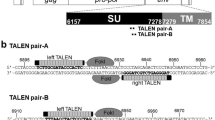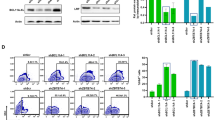Abstract
Equine infectious anemia virus (EIAV) is a lentivirus in the retrovirus family of viruses. Replication-defective EIAV vectors have been constructed that encode bacterial puromycin-N-acetyl transferase and E. coli β-galactosidase. These vectors could be prepared with titers greater than 105 infectious units/ml and were able to act as vehicles to carry genes into cultured human cells. In addition, stable helper cell lines were created by modifying human 293 cells to express EIAV proteins. Unlike retroviral vectors based on murine leukemia virus, EIAV lentiviral vectors transduce nondividing (aphidicolin-arrested) cells. These properties make EIAV vectors promising gene transfer vehicles.
This is a preview of subscription content, access via your institution
Access options
Subscribe to this journal
Receive 12 print issues and online access
$259.00 per year
only $21.58 per issue
Buy this article
- Purchase on SpringerLink
- Instant access to full article PDF
Prices may be subject to local taxes which are calculated during checkout
Similar content being viewed by others
Author information
Authors and Affiliations
Rights and permissions
About this article
Cite this article
Olsen, J. Gene transfer vectors derived from equine infectious anemia virus. Gene Ther 5, 1481–1487 (1998). https://doi.org/10.1038/sj.gt.3300768
Received:
Accepted:
Published:
Issue Date:
DOI: https://doi.org/10.1038/sj.gt.3300768
Keywords
This article is cited by
-
Novel targeted therapies for Parkinson’s disease
Molecular Medicine (2021)
-
Novel lentiviral-inducible transgene expression systems and versatile single-plasmid reporters for in vitro and in vivo cancer biology studies
Cancer Gene Therapy (2015)
-
ALG-2 activates the MVB sorting function of ALIX through relieving its intramolecular interaction
Cell Discovery (2015)
-
ESCRT requirements for EIAV budding
Retrovirology (2013)
-
The Fetal Mouse Is a Sensitive Genotoxicity Model That Exposes Lentiviral-associated Mutagenesis Resulting in Liver Oncogenesis
Molecular Therapy (2013)




